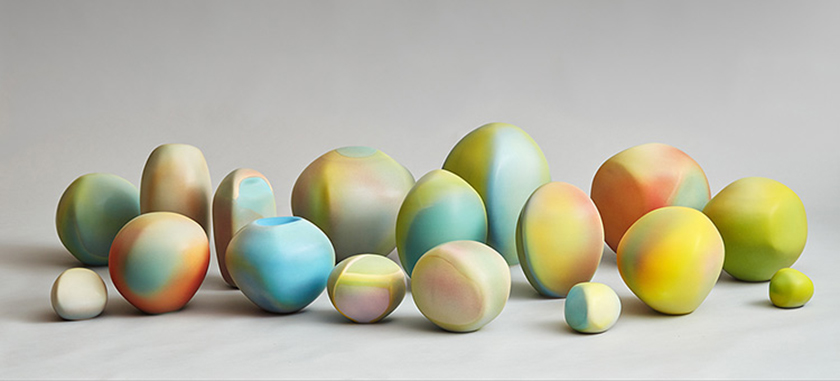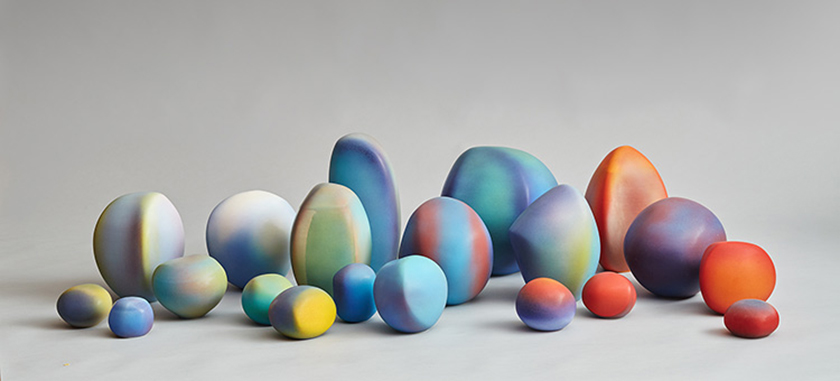The vast sunburned landscapes of the Australian ‘Outback’ account for 70% of Australia’s mainland. It is no wonder then that these ancient deserts have sustained ceramicist Pippin Drysdale with inspiration over her entire career. Born in Melbourne in 1943, Drysdale has mapped the mysterious Australian landscape on her ceramic works for over 30 years.

Portrait by Anthony Browell, courtesy of INDESIGNLIVE.
Pippin struggled with academics while she was growing up but found a great interest in art. Eventually, she had a business selling herbs, and discovered clay through the potter who made ceramic pots for her herbs. She followed her curiosity to an advanced diploma and a bachelor of Fine Art.

Andrew Barnes Photography ‘Dreams Time.’ Image courtesy of Andrew Barnes Photography.
Drysdale is a colorist and painter who uses ceramics as her canvas. The sounds, colors, patterns, light, shadows and topographies of the Outback are abstracted by Drysdale into ceramic forms adorned with markings and colors that aim to celebrate the experience and memories of the Outback.

Pippin Drysdale, Willaminga Water Hotel, Tanami Mapping III, 2014. Porcelain incised with colored glazes. Image courtesy of Pippin Drysdale.
Her vessels evoke dramatic desert sunsets, a cool starry night sky, or surreal natural rock formations. Her work captures the spiritual and cultural significance of the Australian landscape, some of which are the oldest religious sites in the world and of great importance to Australia’s native Aboriginal people.

Pippin Drysdale, Pelikan Pool I, II, III, Pilbara Series 2015 Porcelain incised with colored glazes. Image and details courtesy of Pippin Drysdale.
Drysdale’s technique is to add layers of glaze to a vessel, then making linear incisions through a masking resist to carve delicate patterns in the surface. The lines are then brushed out and filled with color. The inside of the vessels are colored by swirling colored glaze inside it until a perfectly consistent coating is produced.

Inspiring Australian terrain. Image via The Times UK.
The desired effect cannot be achieved by spraying, which would leave the surface powdery and dry. Only small areas can be worked on at a time, meaning a meaning a single vessel can take days to create.

Pippin Drysdale, Rainbow Ledge Breakaway, Pilbara Series, 2015. Porcelain incised with colored glazes. Image and details courtesy of Sabbia Gallery.
A pivotal moment in Pippin Drysdale’s career came while she was on a plane flying over the Northern Territory. The sand dunes below extended far out to the horizon, creating lines in the landscape that Drysdale would return to many times in her work.

Pippin Drysdale, Devils Marbles #4, Central Australia’ Mark Boyle Photography. Image and details courtesy of Dynamic Range.
A recent installation series by Pippin, titled Devils Marbles Collection, 2016, is inspired by the Devils Marbles Conservation Reserve (Karlu Karlu), a protected area in the Northern Territory of Australia. The site is scattered with large boulders, some of which are balanced on top of each other, or split down the middle by natural forces.

Pippin Drysdale, Devils Marbles I – Break of Day. Image courtesy of the artist.
Three collections of ceramic works titled Break of Day, Evensong, and Meridian are grounded in the mesmerizing geological forms in the Reserve and the intensity of colors experienced as a result of the changing desert light throughout the day.
We look forward to seeing new earthly creations by Drysdale as she finds inspiration in her native Australia!

Pippin Drysdale, Devils Marbles I – Evensong. Image courtesy of the artist.